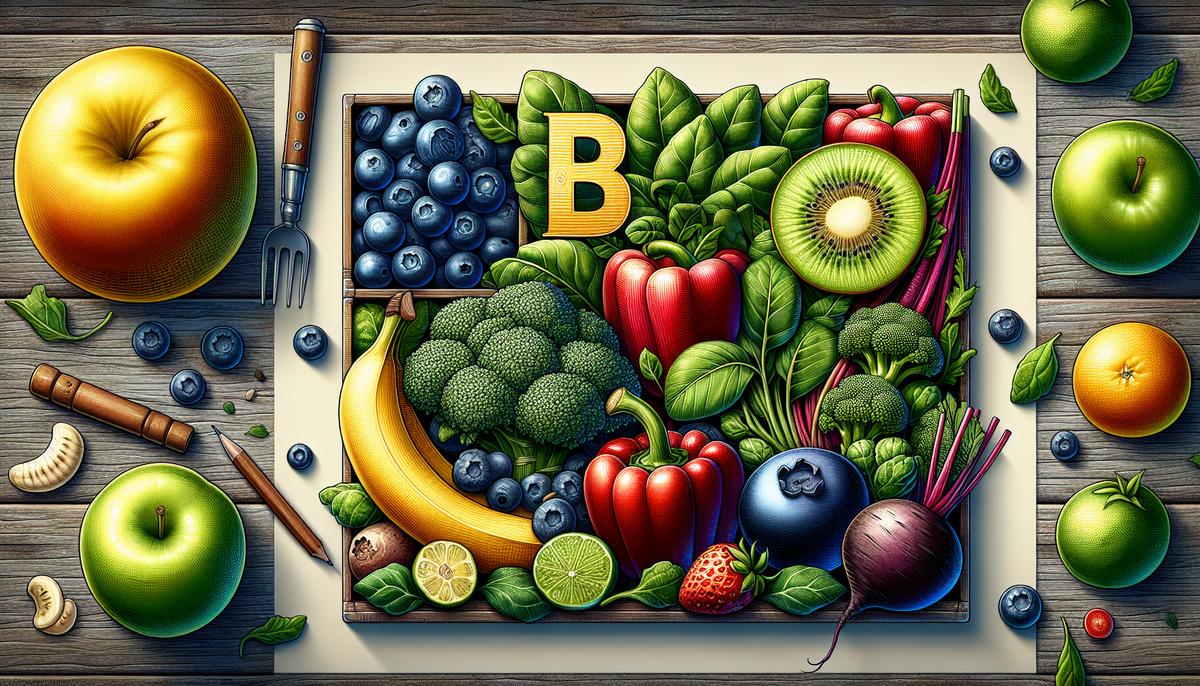Starting your journey toward a healthier lifestyle can often begin with something as simple as incorporating more fruits and vegetables into your diet. Many nutritious options start with the letter “B,” from the widely loved banana to the more exotic black salsify. Each brings its own unique set of flavors, textures, and health benefits. Whether you’re looking to add a bit more variety to your meals or are curious about the nutritional perks of these foods, this guide has got you covered. Let’s explore fruits and vegetables beginning with the letter “B.”
Fruits that start with B
Banana
Bananas are one of the most widely consumed fruits globally, loved for their sweet taste and creamy texture. They are incredibly versatile, perfect for snacking, baking, or even as a base for smoothies. Bananas are typically harvested when green and allowed to ripen, turning yellow as their starch converts to sugar.
Nutritionally, bananas are a powerhouse. They are an excellent source of potassium, which helps regulate blood pressure and support heart health. They also contain vitamin B6, vitamin C, and dietary fiber. The natural sugars in bananas make them a great energy booster, ideal for a pre-workout snack.
In the kitchen, bananas can be used in various ways. Slice them onto your morning cereal, blend them into smoothies, or use them in baking for moist, sweet treats like banana bread or muffins. Frozen bananas also make a delicious and healthy ice cream alternative when blended.
Barbados Cherries
Barbados cherries, also known as acerola cherries, are small, bright red fruits native to the Caribbean and Central America. They are known for their tart flavor and high vitamin C content, which is significantly higher than that of oranges.
These cherries are a fantastic source of antioxidants, which help fight free radicals in the body. They also provide a good amount of vitamin A, important for vision and immune health, as well as small amounts of iron and calcium.
Culinarily, Barbados cherries can be used in various ways. They can be eaten fresh, made into jams and jellies, or used in desserts and beverages. Their tartness pairs well with sweet dishes, making them a popular ingredient in tropical fruit salads and smoothies.
Black Crowberry
Black crowberries are small, dark berries that grow in the colder regions of the Northern Hemisphere. They have a slightly tart taste and are often used in traditional Arctic and Subarctic cuisines.
Nutritionally, black crowberries are rich in antioxidants, particularly anthocyanins, which give the berries their dark color. They also contain vitamin C, fiber, and essential minerals like manganese.
In the kitchen, black crowberries can be used similarly to other berries. They are often made into jams, jellies, and syrups or used in baked goods like pies and muffins. Their tart flavor also makes them a good addition to savory dishes, such as game meat sauces.
Black Currants
Black currants are small, dark purple berries known for their intense flavor and high nutritional value. They are commonly used in European cuisines and are gaining popularity in other parts of the world.
These berries are nutritional powerhouses, packed with vitamin C, antioxidants, and phytochemicals. They also provide a good amount of iron, potassium, and vitamin B5. The antioxidants in black currants help reduce inflammation and support overall health.
Black currants can be used in various culinary applications. They are excellent in jams, jellies, and sauces and can also be used in baking. Their intense flavor makes them a great addition to savory dishes, such as meat glazes and marinades.
Black Nectar Plumcots
Black nectar plumcots are a hybrid fruit, combining the best qualities of plums and apricots. They have a deep purple skin and a sweet, juicy flesh that makes them a delightful summer treat.
Nutritionally, black nectar plumcots offer a range of benefits. They are high in vitamins A and C, which support immune function and skin health. They also contain dietary fiber, which aids in digestion, and various antioxidants that help fight oxidative stress.
In the kitchen, black nectar plumcots can be enjoyed fresh or used in a variety of dishes. They are great in fruit salads, baked goods, and even savory dishes like salads and salsas. Their sweet flavor also makes them an excellent choice for making jams and preserves.
Blackberries
Blackberries are dark purple, almost black, berries known for their sweet and tart flavor. They grow on thorny bushes and are a popular fruit in many parts of the world, especially during the summer months.
These berries are rich in vitamins C and K, as well as dietary fiber. They also contain high levels of antioxidants, particularly anthocyanins, which give the berries their dark color. These nutrients help support immune function, bone health, and digestion.
Culinary uses for blackberries are extensive. They can be eaten fresh, added to cereals and yogurt, or used in baking for pies, muffins, and cobblers. Their tartness also pairs well with savory dishes, such as salads and sauces for meats.
Blood Orange
Blood oranges are a unique variety of orange with a deep red or maroon flesh. They have a sweet and slightly tart flavor, with a hint of raspberry. This striking fruit is as nutritious as it is beautiful.
Blood oranges are an excellent source of vitamin C, which supports immune health. They also contain antioxidants like anthocyanins and flavonoids, which have anti-inflammatory properties. Additionally, they provide fiber, folate, and potassium.
In the kitchen, blood oranges can be used in a variety of dishes. Their juice and zest are great in salads, dressings, and marinades. They can also be used in desserts like cakes and sorbets, or simply enjoyed fresh as a snack.
Blueberries
Blueberries are small, round berries that are blue to purple in color. They are known for their sweet taste and are a popular fruit worldwide, often enjoyed fresh or in various dishes.
Nutritionally, blueberries are packed with antioxidants, particularly anthocyanins. They also provide vitamins C and K, fiber, and manganese. These nutrients help support brain health, heart health, and digestion.
Blueberries can be used in numerous culinary applications. They are perfect for adding to cereals, yogurt, and smoothies. They are also excellent in baking, used in muffins, pies, and pancakes. Their sweet flavor makes them a great addition to salads and sauces.
Boysenberries
Boysenberries are a hybrid fruit, a cross between raspberries, blackberries, and loganberries. They have a sweet-tart flavor and are typically deep purple or maroon in color.
These berries are rich in vitamins C and K, as well as dietary fiber. They also contain antioxidants like anthocyanins and ellagic acid, which have anti-inflammatory properties. These nutrients help support immune function, bone health, and digestion.
Boysenberries can be used in a variety of culinary applications. They are great for making jams, jellies, and sauces, and can also be used in baking. Their sweet-tart flavor makes them a good addition to both sweet and savory dishes.
Brazil Nuts
Brazil nuts are large, crescent-shaped nuts native to the Amazon rainforest. They have a rich, creamy texture and a slightly sweet flavor, making them a popular snack and ingredient in various dishes.
These nuts are an excellent source of selenium, a mineral that supports thyroid function and immune health. They also provide healthy fats, protein, fiber, and essential minerals like magnesium and zinc.
In the kitchen, Brazil nuts can be enjoyed on their own as a snack, or added to dishes for extra crunch and nutrition. They are great in baked goods, salads, and granolas. Their rich flavor also makes them a good addition to savory dishes, such as pestos and nut butters.
Breadfruit
Breadfruit is a large, green fruit native to the Pacific Islands. It has a starchy texture and a mildly sweet flavor, similar to that of freshly baked bread, which is how it got its name.
Nutritionally, breadfruit is rich in carbohydrates, making it an excellent energy source. It also provides fiber, vitamins C and B, and essential minerals like potassium and magnesium. These nutrients help support energy levels, digestion, and overall health.
Breadfruit can be used in a variety of culinary applications. It can be boiled, roasted, or fried, and is often used as a substitute for potatoes in many dishes. It can also be made into breadfruit chips or used in soups and stews.
Brown Turkey Figs
Brown Turkey figs are a variety of fig known for their sweet flavor and dark brownish-purple skin. They are typically enjoyed fresh but can also be dried for longer storage.
Nutritionally, Brown Turkey figs are rich in fiber, which aids in digestion. They also provide vitamins A, C, and K, as well as essential minerals like potassium and calcium. These nutrients help support bone health, immune function, and overall wellness.
In the kitchen, Brown Turkey figs can be enjoyed fresh as a snack, or used in various dishes. They are great in salads, paired with cheese, or used in baking for cakes and tarts. Their sweet flavor also makes them a good addition to savory dishes, such as roasted meats and sauces.
Vegetables that start with B
Baby Candy Cane Beets
Baby Candy Cane Beets are a visually striking variety of beet with concentric red and white rings. They have a sweet, earthy flavor and are often harvested when small and tender.
Nutritionally, these beets are rich in fiber, folate, and manganese. They also provide vitamins A and C, as well as antioxidants like betalains, which have anti-inflammatory properties. These nutrients help support heart health, digestion, and overall wellness.
In the kitchen, Baby Candy Cane Beets can be used in various ways. They are great roasted, boiled, or pickled, and can be added to salads for a pop of color and flavor. Their sweet taste also pairs well with savory dishes, such as goat cheese and walnuts.
Baby Oyster Mushrooms
Baby Oyster Mushrooms are a small, tender variety of oyster mushroom. They have a delicate flavor and a slightly chewy texture, making them a popular choice in many cuisines.
These mushrooms are a good source of protein, fiber, and various vitamins and minerals, including B vitamins, selenium, and copper. They also contain antioxidants and have anti-inflammatory properties, which help support overall health.
Culinary uses for Baby Oyster Mushrooms are extensive. They can be sautéed, roasted, or added to soups and stews. Their delicate flavor also makes them a great addition to pasta dishes, risottos, and stir-fries.
Banana Squash
Banana Squash is a large, elongated squash with a pale yellow to orange skin. It has a sweet, nutty flavor and a firm, smooth texture, making it a versatile ingredient in many dishes.
Nutritionally, Banana Squash is rich in vitamins A and C, which support immune function and skin health. It also provides dietary fiber, potassium, and various antioxidants, which help support heart health and digestion.
In the kitchen, Banana Squash can be used in various ways. It is great roasted, mashed, or pureed, and can be used in soups, stews, and casseroles. Its sweet flavor also makes it a good addition to baked goods, such as muffins and pies.
Beets
Beets are root vegetables with a deep red or purple color and a sweet, earthy flavor. They are a popular ingredient in many cuisines and can be enjoyed both raw and cooked.
These root vegetables are rich in fiber, folate, and manganese. They also provide vitamins A and C, as well as antioxidants like betalains, which have anti-inflammatory properties. These nutrients help support heart health, digestion, and overall wellness.
Culinary uses for beets are extensive. They can be roasted, boiled, or pickled, and are great in salads, soups, and side dishes. Their sweet flavor also pairs well with savory dishes, such as goat cheese and walnuts.
Belgian Endive
Belgian Endive is a type of leafy vegetable with a slightly bitter flavor and a crisp, crunchy texture. It is often used in salads and as a base for various appetizers.
Nutritionally, Belgian Endive is low in calories and high in vitamins A and K, which support immune function and bone health. It also provides fiber, folate, and various antioxidants, which help support overall health.
In the kitchen, Belgian Endive can be used in various ways. It is great in salads, paired with fruit and cheese, or used as a base for appetizers. Its slightly bitter flavor also makes it a good addition to savory dishes, such as soups and stews.
Bell Peppers
Bell Peppers are a type of sweet pepper that come in various colors, including green, red, yellow, and orange. They have a crisp texture and a mild, sweet flavor, making them a popular ingredient in many dishes.
These peppers are rich in vitamins A and C, which support immune function and skin health. They also provide dietary fiber, folate, and various antioxidants, which help support heart health and digestion.
Culinary uses for Bell Peppers are extensive. They can be eaten raw, added to salads, or used in cooking for stir-fries, fajitas, and stuffed peppers. Their sweet flavor also makes them a good addition to soups and stews.
Bitter Melon
Bitter Melon is a tropical vegetable with a distinct, bitter flavor and a warty, green exterior. It is commonly used in Asian and African cuisines for its unique taste and various health benefits.
Nutritionally, Bitter Melon is low in calories and high in vitamins C and A, which support immune function and skin health. It also provides fiber, folate, and various antioxidants, which help support overall health.
In the kitchen, Bitter Melon can be used in various ways. It is often stir-fried, stuffed, or used in soups and stews. Its bitter flavor also makes it a good addition to savory dishes, such as curries and braises.
Black Beans
Black Beans are small, shiny beans with a deep black color and a slightly sweet, earthy flavor. They are a staple in many Latin American and Caribbean cuisines and are known for their versatility and nutritional benefits.
These beans are rich in protein, fiber, and various vitamins and minerals, including iron, magnesium, and folate. They also provide antioxidants, which help support overall health and reduce inflammation.
Culinary uses for Black Beans are extensive. They can be used in soups, stews, and salads, or as a base for dips and spreads. Their hearty flavor also makes them a great addition to rice dishes, burritos, and tacos.
Black Eyed Peas
Black Eyed Peas are small, creamy-colored beans with a black spot, or “eye,” on their surface. They have a mild, earthy flavor and are a staple in Southern and African cuisines.
Nutritionally, Black Eyed Peas are rich in protein, fiber, and various vitamins and minerals, including folate, iron, and magnesium. They also provide antioxidants, which help support overall health and reduce inflammation.
In the kitchen, Black Eyed Peas can be used in various ways. They are great in soups, stews, and salads, or as a side dish. Their mild flavor also makes them a good addition to rice dishes, such as Hoppin’ John, a traditional Southern dish.
Black Radish
Black Radish is a root vegetable with a dark, almost black skin and a white, crisp interior. It has a strong, peppery flavor and is often used in salads and as a garnish.
These radishes are rich in vitamin C, fiber, and various antioxidants. They also provide essential minerals like potassium and magnesium, which help support heart health and overall wellness.
Culinary uses for Black Radish are extensive. They can be eaten raw, sliced thin for salads, or used as a garnish. Their peppery flavor also makes them a good addition to savory dishes, such as soups and stews.
Black Salsify
Black Salsify is a root vegetable with a dark, almost black skin and a white, creamy interior. It has a mild, slightly sweet flavor and is often used in soups and stews.
Nutritionally, Black Salsify is rich in fiber, vitamins C and B6, and various minerals, including potassium and iron. These nutrients help support heart health, digestion, and overall wellness.
In the kitchen, Black Salsify can be used in various ways. It is great roasted, boiled, or pureed, and can be added to soups and stews. Its mild flavor also makes it a good addition to savory dishes, such as gratins and casseroles.
Bok Choy
Bok Choy is a type of Chinese cabbage with a mild, slightly sweet flavor and a crisp, crunchy texture. It is a popular ingredient in Asian cuisines and is often used in stir-fries and soups.
This leafy vegetable is rich in vitamins A, C, and K, which support immune function, skin health, and bone health. It also provides fiber, calcium, and various antioxidants, which help support overall health.
Culinary uses for Bok Choy are extensive. It can be stir-fried, added to soups, or used in salads. Its mild flavor also makes it a good addition to savory dishes, such as dumplings and spring rolls.
Boniato
Boniato is a type of sweet potato with a white flesh and a slightly sweet, nutty flavor. It is a staple in Caribbean and Latin American cuisines and is often used in various dishes.
Nutritionally, Boniato is rich in fiber, vitamins A and C, and various antioxidants. It also provides essential minerals like potassium and magnesium, which help support heart health and overall wellness.
In the kitchen, Boniato can be used in various ways. It is great roasted, mashed, or fried, and can be used in soups, stews, and casseroles. Its sweet flavor also makes it a good addition to baked goods, such as pies and muffins.
Broccoflower
Broccoflower is a hybrid vegetable, a cross between broccoli and cauliflower. It has a mild, slightly sweet flavor and a vibrant green color, making it a visually appealing addition to any dish.
Nutritionally, Broccoflower is rich in vitamins C and K, which support immune function and bone health. It also provides fiber, folate, and various antioxidants, which help support overall health.
In the kitchen, Broccoflower can be used in various ways. It is great steamed, roasted, or used in salads. Its mild flavor also makes it a good addition to savory dishes, such as stir-fries and casseroles.
Broccoli
Broccoli is a cruciferous vegetable with a mild, slightly bitter flavor and a crisp, crunchy texture. It is a popular ingredient in many cuisines and is known for its nutritional benefits.
Nutritionally, broccoli is a powerhouse. It is rich in vitamins C, K, and A, as well as folate, fiber, and potassium. These nutrients support immune function, bone health, and cardiovascular health. Broccoli also contains sulforaphane, a compound with potent antioxidant and anti-inflammatory properties.
Culinary uses for broccoli are extensive. It can be steamed, roasted, stir-fried, or used in soups and salads. Its hearty texture makes it a great addition to casseroles, pasta dishes, and even as a pizza topping.
Broccoli Rabe
Broccoli Rabe, also known as rapini, is a leafy green vegetable with small, broccoli-like buds and a slightly bitter taste. It is commonly used in Italian and Mediterranean cuisines.
Nutritionally, broccoli rabe is rich in vitamins A, C, and K, as well as calcium, iron, and fiber. These nutrients help support vision, immune function, and bone health. The vegetable also contains antioxidants and phytochemicals that contribute to overall health.
In the kitchen, broccoli rabe can be sautéed, steamed, or blanched. It is often paired with garlic, olive oil, and lemon to balance its bitterness. It is a great addition to pasta dishes, sandwiches, and frittatas.
Broccolini
Broccolini is a hybrid vegetable, a cross between broccoli and Chinese kale. It has long, slender stems, small florets, and a sweet, mild flavor.
Nutritionally, broccolini is packed with vitamins A, C, and K, as well as fiber, folate, and iron. These nutrients support immune function, skin health, and red blood cell production. Broccolini also contains antioxidants that help protect against chronic diseases.
In the kitchen, broccolini can be grilled, roasted, steamed, or stir-fried. Its tender stems and florets make it a great addition to salads, pasta dishes, and stir-fries. It pairs well with lemon, garlic, and Parmesan cheese.
Brussels Sprouts
Brussels sprouts are small, cabbage-like vegetables with a nutty, slightly sweet flavor. They are often roasted or sautéed to enhance their natural sweetness.
Nutritionally, Brussels sprouts are rich in vitamins C and K, as well as fiber, folate, and manganese. These nutrients support immune function, bone health, and digestion. Brussels sprouts also contain glucosinolates, compounds with potential cancer-fighting properties.
Culinary uses for Brussels sprouts are diverse. They can be roasted, steamed, or sautéed, and make a great addition to salads, pasta dishes, and grain bowls. They pair well with bacon, balsamic vinegar, and maple syrup.
Burdock Root
Burdock root is a root vegetable with a sweet, earthy flavor and a crisp texture. It is commonly used in Japanese and Korean cuisines.
Nutritionally, burdock root is rich in fiber, vitamin C, and various antioxidants. It also provides inulin, a prebiotic fiber that supports gut health. Burdock root is known for its detoxifying properties and its potential to support liver health.
In the kitchen, burdock root can be used in soups, stews, and stir-fries. It can also be pickled or used in teas. Its unique flavor and texture make it a versatile ingredient in a variety of dishes.
Butter Lettuce
Butter lettuce, also known as Bibb or Boston lettuce, is a type of lettuce with soft, buttery leaves and a mild, sweet flavor.
Nutritionally, butter lettuce is a good source of vitamins A and K, as well as folate and iron. These nutrients support vision, bone health, and red blood cell production. Butter lettuce is also low in calories and high in water content, making it a hydrating and low-calorie addition to meals.
Culinary uses for butter lettuce are numerous. It is often used in salads, wraps, and sandwiches. Its tender leaves make it a great base for delicate dressings and toppings.
Buttercup Squash
Buttercup squash is a type of winter squash with a sweet, nutty flavor and a dense, creamy texture. It has a dark green skin and a vibrant orange flesh.
Nutritionally, buttercup squash is rich in vitamins A and C, as well as fiber and potassium. These nutrients support immune function, vision, and heart health. Buttercup squash is also high in antioxidants that help protect against chronic diseases.
In the kitchen, buttercup squash can be roasted, mashed, or pureed. It is great in soups, stews, and casseroles. Its sweet flavor also makes it a good addition to baked goods, such as pies and muffins.
Butternut Squash
Butternut squash is a type of winter squash with a sweet, nutty flavor and a smooth, creamy texture. It has a tan skin and a bright orange flesh.
Nutritionally, butternut squash is packed with vitamins A and C, as well as fiber and potassium. These nutrients support immune function, vision, and heart health. Butternut squash also contains antioxidants that help protect against chronic diseases.
Culinary uses for butternut squash are extensive. It can be roasted, mashed, or pureed. It is great in soups, stews, and casseroles. Its sweet flavor also makes it a good addition to baked goods, such as pies and muffins.




